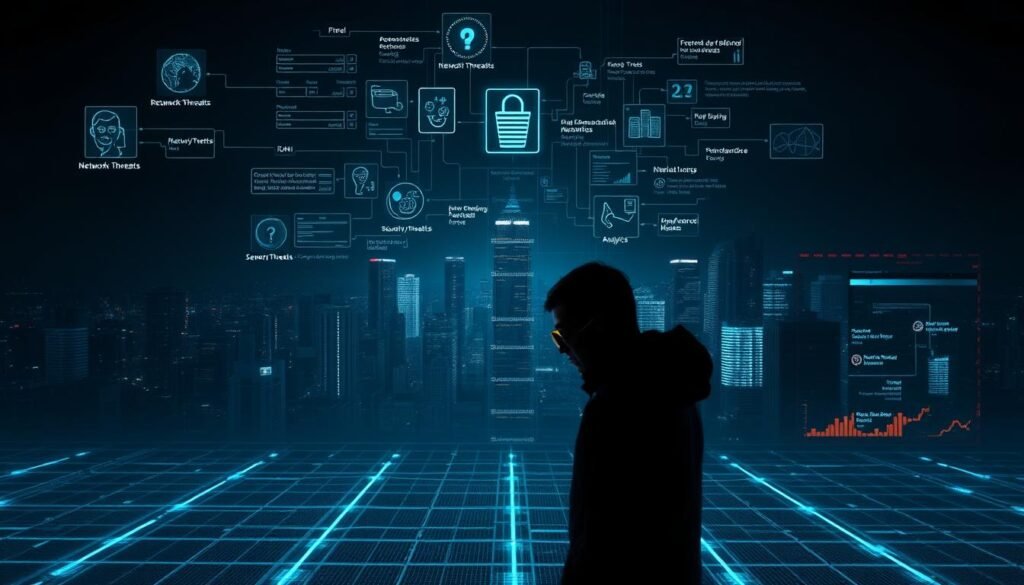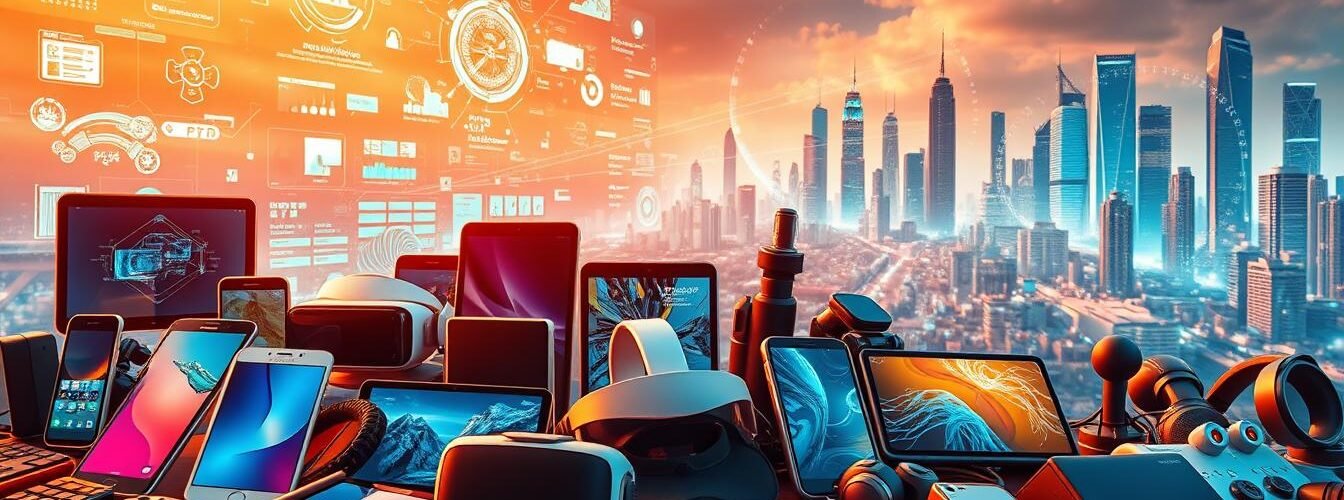Major Trends in Technology Togtechify are reshaping U.S. businesses and daily life in 2025. This guide gives clear, action-ready insight into the biggest shifts — from AI and cloud-to-edge computing to IoT growth and stronger cybersecurity powered by predictive analytics and AI defense.
Why it matters: faster decisions, safer systems, and measurable efficiency gains for healthcare, retail, finance, and manufacturing. We highlight how 5G plus edge enables real-time control for vehicles, factories, and hospitals.
Expect plain language and practical steps. We show blockchain use for supply chains and digital identity, and XR for training and retail demos. Each example is aimed at U.S. organizations considering pilots or scaling solutions.
Ready to move beyond hype to real value? Read on for concrete tools and next steps that make the future tangible and reliable.
Key Takeaways
- AI and predictive analytics deliver faster, safer decisions.
- Cloud-to-edge computing enables real-time, mission-critical systems.
- 5G accelerates IoT and immersive XR experiences.
- Blockchain increases trust across supply chains and identity.
- Clear, actionable guidance helps U.S. businesses test and scale.
Why These Major Tech Trends Matter Now
Today’s market forces push organizations to adopt smarter systems at speed.
Shifting customer expectations, tighter margins, and faster innovation cycles make technology decisions urgent. Companies that act gain scale and flexibility from cloud and hybrid setups. IoT adds value by linking homes and industrial networks for real-time insights.
Outcomes are concrete: faster time-to-value, lower costs, better resilience, and tighter compliance. Data maturity drives personalization, predictive maintenance, and routine automation—clear advantages for U.S. businesses and industries.

Security risks have surged: ransomware and phishing push teams to adopt AI-driven detection and zero-trust access. 5G lowers latency for telemedicine, XR, and remote manufacturing control. Green compute and energy-efficient data centers reduce emissions while cutting operating costs.
- Focus on high-ROI pilots and build a solid data foundation.
- Upskill teams and address board concerns: risk, security, talent, and sustainability.
- Plan for convergence—AI plus IoT, edge, and XR compound value.
Start with a roadmap: prioritize quick wins, measure efficiency, and scale pilots into production.
Artificial Intelligence and Machine Learning Powering the Present
Today’s machine learning systems power live services that customers rely on every day.
Applied and agentic AI are practical: they analyze signals, decide, and act rather than just score data. These systems run chatbots, recommendation engines, and automated back-office flows that speed support and cut manual steps.
Generative AI tools like ChatGPT and DALL·E streamline marketing content and design work. Use them with governance: human review, watermarking, and transparent policies to manage bias and IP risk.

- Faster support and better recommendations improve customer retention.
- Healthcare diagnostics, fraud detection, and retail personalization show clear ROI.
- Data readiness and MLOps pipelines are essential for reliable deployment.
“Agentic intelligence is not about replacing experts. It augments decisions and shortens cycles.”
| Type | Primary Role | Key Outcome |
|---|---|---|
| Applied AI | Automate tasks | Faster workflows |
| Agentic AI | Monitor and act | Autonomous decisions |
| Generative AI | Create content & code | Creative speed |
Start small: pick one customer-facing or ops use case, measure analytics, iterate, then scale across companies and industries!
Cybersecurity, Zero-Trust, and AI-Driven Defense
Every day, companies face smarter attacks that demand faster, automated defenses.
Organizations now see frequent data breaches, phishing scams, and ransomware. That new normal requires proactive defense beyond perimeter controls. Critical systems and smart-city networks need resilient, verified access to stay online.

From ransomware to phishing: Evolving threats and predictive analytics
AI-powered cybersecurity detects anomalies, applies behavior analytics, and triggers automated responses. Predictive models cut dwell time and lower human error.
Zero-trust architecture, encryption, and access controls in practice
Practical steps: verify explicitly, assume breach, enforce least-privilege, and use micro-segmentation across cloud and on-prem systems.
- Use encryption, MFA/biometrics, and hardware security keys for sensitive workloads.
- Enable continuous configuration monitoring and identity governance for cloud and SaaS.
- Segment OT networks for utilities, transit, and healthcare with real-time monitoring.
| Goal | Action | Measure |
|---|---|---|
| Faster detection | AI anomaly spotting | Mean time to detect |
| Lower risk | Least-privilege + MFA | Phishing click rate |
| Regulatory readiness | Centralized logging | Audit time |
Practice matters: run tabletop exercises, maintain incident playbooks, and train staff to reduce human error. Track KPIs like MTTR, patch latency, and phishing click rates to prove value to leaders and regulators.
Cloud Computing to Edge Computing: The Shift to Real-Time
Today’s systems place critical processing closer to devices for faster action and lower bandwidth use.
Hybrid and multi-cloud for scale and cost-efficiency
Cloud platforms and hybrid setups deliver scalability, flexibility, and cost-efficiency for modern services. You can run heavy analytics in the cloud while keeping latency-sensitive tasks near users.
Edge for low-latency data processing in factories, vehicles, and hospitals
Edge computing processes data locally to reduce latency. That enables vehicle safety stacks, machine vision on assembly lines, and bedside monitoring with instant alerts.
- Central cloud: elasticity and deep analytics.
- Edge nodes: real-time decisions and lower bandwidth use.
- Hybrid wins: avoid vendor lock-in and place workloads where they perform best.

“Keep sensitive data local, send summaries to the cloud for model training.”
| Layer | Primary Role | Key Benefit | Typical Tools |
|---|---|---|---|
| Cloud | Aggregation & analytics | Scale and cost-efficiency | Containers, managed databases |
| Edge | Local processing | Low-latency response | Kubernetes at edge, container runtimes |
| Hybrid | Workload placement | Flexibility and resilience | Multi-cloud orchestration, GitOps |
| Network | Transport | Real-time connectivity | 5G, private IIoT links |
Deployment note: start with a pilot at one site, tune models and observability, then replicate. Use right-size instances, autoscaling, and edge caching to control costs. Secure devices with cert-based identity and encrypted messaging to maintain trust and SLOs.
5G Connectivity Accelerating IoT, XR, and Smart Industries
5G lets devices talk with almost no lag, unlocking real-time services across sectors.
What the upgrade delivers: lower latency and far greater capacity make dense device deployments reliable. Telecoms extend networks so AR, iot, and low-latency systems run smoothly for users and operators.
Benefits span industries and services. XR gets fluid AR guidance for field crews. Factories use synchronized robots and mobile asset tracking to improve safety. Healthcare gains high-fidelity telemedicine and continuous patient monitoring.
- Scale: support more devices with stable links and better battery life.
- Edge synergy: process locally, send only relevant data to the cloud.
- Security: SIM-based identity, network slicing isolation, and end-to-end encryption protect flows.
“Start with one high-impact workflow—like AR maintenance—to prove ROI fast.”
Commercial models: private 5G for campuses, carrier reach for broad coverage, and neutral-host options for shared venues. Begin small, measure latency and uptime, then expand.
Internet of Things and Smart Ecosystems
Connected sensors now turn routine signals into fast, useful decisions across homes and cities. IoT links residences, enterprises, and public systems to deliver predictive maintenance, inventory tracking, health monitoring, and smarter energy use.
Smart homes, cities, and industrial IoT: Sensors to insights
Map the flow: sensors capture signals; gateways normalize them; platforms analyze; apps drive action. This chain turns raw data into alerts, schedules, and automated controls.
Smart homes reduce bills with adaptive heating, secure assets with cameras, and simplify control through voice assistants. Industrial systems use condition monitoring to cut downtime and raise OEE.
Smart cities deploy traffic sensors, smart grids, and waste analytics to ease congestion and improve air quality. These deployments help multiple industries and public services run cleaner and safer.
Wearables, precision agriculture, and asset tracking
Wearables deliver continuous health and fitness signals that feed preventive care. Agriculture uses soil moisture sensors, nutrient probes, and drone imagery to raise yields while saving water and fertilizer.
Asset tracking gives real-time location, temperature, and shock telemetry for logistics assurance. Manage the data lifecycle with secure ingestion, edge filtering, storage tiers, and retention policies to control costs.
- Privacy and compliance: anonymize streams and enforce policies across shared infrastructure.
- Adoption tip: pick a clear KPI—downtime reduction, energy savings, or SLA improvement—and start with one pilot.
“Start with a focused use case and measure relentlessly to scale with confidence.”
Blockchain Technology Trends and Decentralized Solutions
Immutable records and automated contracts cut reconciliation time and lower disputes.
Why it matters: distributed ledgers, consensus, and immutability create auditable records across partners. This reduces manual reconciliation and brings verifiable provenance to complex workflows.
Practical uses: smart contracts automate enforcement and speed multi-party approvals. Supply chains track provenance, temperature logs, and custody changes—critical for food and pharma.
Digital identity schemes give portable credentials for KYC and cross-border verification. Financial services test programmable money for instant settlement and lower fraud risk.
Public pilots include tamper-evident voting trials and document registries. Healthcare explores patient-controlled records and secure provider exchanges.
Integration and security essentials
Best practice pairs off-chain storage for bulk data with on-chain hashes for integrity. Key management, permissioned networks, and smart contract audits cut risk.
“Time-to-reconcile and dispute rates fall as transparency rises.”
| Use case | Primary benefit | Metric |
|---|---|---|
| Supply chain | Provenance & cold-chain logs | Dispute rate ↓ |
| Digital identity | Portable verification | Onboarding time ↓ |
| Finance | Instant settlements | Settlement time ↓ |
Extended Reality: AR, VR, and Spatial Computing at Work
Extended reality blends real and virtual workspaces to make hands-on learning safer and faster.
XR combines augmented reality and virtual reality with spatial computing to create immersive, task-focused experiences. Retail uses AR try-ons; healthcare leverages VR for surgical rehearsal. Spatial devices like Apple Vision Pro push mainstream adoption.
- Safer, repeatable training that measures skill gains and lowers risk.
- Shared 3D workspaces for remote collaboration, design reviews, and live field support.
- Retail and CPQ demos that boost conversion with interactive product experiences.
Healthcare benefits include exposure therapy, surgical rehearsal, and patient education with adaptive visuals. Field service gets hands-free AR instructions and remote expert guidance to cut downtime.
Technical notes: content lifecycle needs 3D asset creation, optimization, and cross-device distribution. Edge rendering and 5G help reduce motion-to-photon latency so the user stays comfortable.
“Measure ROI with training completion, first-time fix rates, and customer satisfaction.”
Datafication and Advanced Analytics
Turning events into structured signals helps teams move from guesswork to clear actions.
Datafication captures signals from apps, devices, and processes. Tools like Power BI, Tableau, and Google Analytics turn raw data into visual dashboards. These platforms let teams spot patterns and act fast.
Benefits reach retail, healthcare, education, and transport. Personalized marketing and better inventory control lift ROI. Predictive analytics improve routing, demand forecasting, and customer experience.
- Define: capture, structure, and analyze signals for decision points.
- Tooling: BI platforms and embedded analytics build operational dashboards.
- Personalization: behavior-driven recommendations that boost conversion and lifetime value.
- Operational excellence: forecast demand, optimize routes, and right-size inventory.
- Model ops: versioning, drift monitoring, and retraining keep models healthy.
- Privacy-first: anonymization, consent management, and policy-by-design for regulated sectors.
- Governance: HIPAA-aligned handling, audit logs, and role-based access for health and finance.
- Data contracts and skills uplift help businesses self-serve insights and reduce breakage.
“Define decision points and KPIs before building dashboards.”
| Use case | Primary benefit | KPI |
|---|---|---|
| Personalization | Higher conversion & engagement | Conversion rate uplift |
| Demand forecasting | Lower stockouts & waste | Fill rate / Inventory turns |
| Operational routing | Faster delivery & lower cost | On-time rate / Cost per mile |
Focus on outcomes: align dashboards to decisions, train teams on basic analytics, and embed privacy patterns during development to keep trust and compliance strong.
Automation, Robotics, and Polyfunctional Systems
From software screens to factory floors, automation now tackles routine tasks and complex physical work.
RPA handles repetitive digital jobs like data entry and claims processing. The market shows steady growth through 2030 as businesses chase faster cycle times and lower error rates.
Collaborative robots (cobots) boost throughput in logistics, healthcare, and manufacturing. They do pick/pack, machine tending, medication dispensing, and vision-guided inspection.
Polyfunctional systems pair AI with reconfigurable robots. Google DeepMind’s Gemini robotics shows how multimodal reasoning lets machines handle varied tasks on the fly.
- Integration: link RPA and robots to ERP, EHR, and WMS for end-to-end workflows.
- Safety: use collaborative modes, geofencing, and continuous monitoring.
- Workforce: reskill staff to supervise bots and manage exceptions.
“Start with one process, measure cycle-time and error rate, then scale.”
| Domain | Common Use | Key Metric |
|---|---|---|
| Logistics | Pick/pack, sortation | Throughput ↑ |
| Healthcare | Intake automation, cobots | Error rate ↓ |
| Manufacturing | Welding, inspection | Yield ↑ |
Quantum Technologies and Post-Quantum Cryptography
Quantum systems rewrite what’s tractable for certain computing tasks. Qubits use superposition and entanglement, not simple bits, so they can explore many states at once. That allows new classes of algorithms for optimization and simulation.
Early use cases include portfolio optimization, drug-discovery simulations, and logistics routing that squeeze out faster answers for finance and life sciences.
There is a real security risk: classical encryption may be vulnerable to future quantum attacks. Harvest-now, decrypt-later is a concern for long-lived data and critical infrastructure.
- Plan a post-quantum path: test NIST-backed algorithms and build crypto-agility into your systems.
- Use hybrid approaches: classical + quantum-inspired methods give benefits today.
- Prioritize records: upgrade protection for long-lived, sensitive data first.
“Inventory your cryptography, set migration timelines, and test at small scale before broad rollout.”
Cloud-accessible quantum services let teams experiment without heavy hardware. Watch hardware roadmaps and error-correction progress to time adoption. Train architects on quantum-safe design—this prepares your teams and your industries for a secure future!
Sustainable Technology and Green Infrastructure
Energy-aware design for compute and data flows is a practical step toward net-zero goals.
Why it matters: sustainable technology reduces emissions and lowers operating cost for businesses. Smart choices across cloud, edge, and on-prem systems cut energy use and improve resilience.
Energy-efficient compute and renewable-powered data centers
Move workloads to renewable-powered data centers via PPAs. Use advanced cooling like liquid or immersion to trim power draw.
Circular IT and software efficiency
Right-size device fleets, refurbish equipment, and recycle responsibly to extend lifecycles. Optimize models and code paths to reduce compute cycles and energy waste.
- Track PUE and emissions per workload with observability tools.
- Include energy and recyclability criteria in procurement and RFPs.
- Place workloads (edge vs cloud) to minimize data movement and energy loss.
| Area | Approach | Business benefit |
|---|---|---|
| Data centers | Renewable PPAs, liquid cooling | Lower energy cost & emissions |
| Hardware | Energy-efficient CPUs/GPUs, right-sizing | Less idle draw, lower OPEX |
| Software & Ops | Model/code optimization, observability | Fewer compute cycles, better compliance |
| Procurement | ESG-aligned RFPs | Brand trust and regulatory readiness |
Quick action: start with one measurable pilot: track energy, costs, and emissions. Report gains to stakeholders and map efforts to ESG frameworks to scale with confidence.
Low-Code/No-Code Platforms Speeding Development
Visual builders let non-technical teams create real apps fast.
Why it matters: these platforms reduce time-to-market and ease pressure from developer shortages. Small and mid-size businesses can launch forms, portals, and lightweight mobile apps with lower upfront cost.
Use cases include internal portals, workflow automation, and data capture. Integration connectors link CRM, ERP, and analytics so systems avoid silos.
Governance: add guardrails for security, role-based data access, and lifecycle controls. Built-in testing, versioning, and CI/CD keep releases reliable.
- Fusion teams—IT + business—co-create usable solutions.
- Standardize templates and component libraries to scale.
- Upskill citizen developers with training and certification.
“Measure success with backlog reduction, cycle time cuts, and stakeholder satisfaction.”
| Value | Common Use | Key Metric |
|---|---|---|
| Faster delivery | Internal portals | Cycle time ↓ |
| Lower cost | Workflow automation | ROI time ↓ |
| Better collaboration | Mobile data capture | Stakeholder satisfaction ↑ |
Voice, Conversational AI, and Next-Gen Chatbots
Voice assistants and chatbots are moving from simple scripts to true context-aware helpers. They cut customer service costs by up to 30% while working across web and messaging platforms.
Modern conversational AI uses multi-turn understanding, context retention, and omnichannel reach. That lets teams scale support with 24/7 automated answers for FAQs, order tracking, and troubleshooting.
Personalization improves with NLP and intent models that route queries to the right flows. Agent assist tools summarize calls, surface knowledge, and recommend next best actions to human reps.
- Voice growth: from search to payments — hands-free convenience drives adoption.
- Safety: content filters, escalation logic, and audit trails protect compliance.
- Integration: tie chat to CRMs and ticketing systems for closed-loop resolution.
“When bots handle routine work well, human agents focus on higher-value support.”
| Capability | Benefit | Key KPI |
|---|---|---|
| Omnichannel chat | Consistent experience across channels | Containment rate ↑ |
| Voice assistants | Hands-free tasks and transactions | Average handle time ↓ |
| Agent assist | Faster case resolution | First-contact resolution ↑ |
Optimize by A/B testing prompts, flows, and tone with lightweight tools to raise CSAT. Ensure accessibility so every user can reach support easily.
Practical note: start with one customer workflow, measure containment and resolution, then expand to other services. U.S. businesses gain both cost savings and better user satisfaction.
Major Trends in Technology Togtechify
We follow practical deployments where AI meets sensors, secure identity, and fast networks to solve real problems.
What TogTechify tracks
Core focus areas: applied AI, IoT and smart connectivity, zero-trust cybersecurity, blockchain-based identity, edge + 5G, and XR for training and collaboration.
Examples include predictive maintenance pipelines that run models at the edge, blockchain proofs for supply-chain custody, and XR kits that let remote experts guide repairs.
Converging innovations: where combined tech delivers outsized impact
When systems combine, outcomes accelerate. AI + IoT + edge gives instant decisions at the source. Blockchain + digital identity enables trusted access across partners. XR + 5G delivers real-time remote expertise.
- Cross-sector wins: healthcare remote monitoring, finance fraud controls, retail personalized service, manufacturing predictive repair, public-sector asset tracking.
- Playbook: start small, measure KPIs, secure data flows, then scale iteratively.
- Governance & resilience: privacy, ethics, and incident plans must sit inside every stack.
- Tools of choice: cloud+edge orchestration, MLOps, DevSecOps, and analytics platforms drive repeatable solutions.
“Design adaptable architectures that evolve as models and networks improve.”
Value promise: pragmatic guidance that lowers risk and speeds adoption for U.S. companies and industries. Use the next section to translate these signals into a concrete roadmap for pilots and scale.
How U.S. Businesses Can Act on These Trends Today
Start with a single, measurable pilot that proves value fast and limits risk.
Prioritize pilots, build data foundations, and upskill teams
Pick one high-ROI pilot — AI customer support, IoT maintenance, or XR training. Keep scope tight and define KPIs before you start.
- Build a data foundation: governance, quality pipelines, and BI access so leaders can act on clean data.
- Secure by design: deploy zero-trust, encryption, and continuous monitoring for resilient systems.
- Modernize architecture: hybrid cloud plus edge where latency and privacy matter.
- Measure outcomes: publish KPI results to prove value and drive funding.
- Upskill teams: AI literacy, prompt engineering, analytics, and cloud security for lasting capability.
- Choose partners with clear roadmaps, references, and compliance posture.
- Bake in sustainability: energy dashboards and right-sizing to cut cost and carbon.
- Plan scaling: templates, reusable components, and platform standards to avoid sprawl.
Conclusion
Adopt with purpose: small experiments unlock big operational gains and guide broader development.
Recap: AI, iot, cloud computing, and edge computing deliver tangible value for manufacturing, services, and customer experiences. Use data and analytics to prove ROI quickly.
Responsible adoption matters. Prioritize privacy, cybersecurity, and sustainable energy choices. Choose the right platforms so processing happens where it makes sense.
Pair systems—machine learning with low-latency devices, blockchain and zero-trust for trust—and run pilots with clear metrics. Upskill teams so your companies stay nimble and confident.
Final note: focus on customers, measure efficiency, and follow updates from TogTechify to navigate change with assurance!







